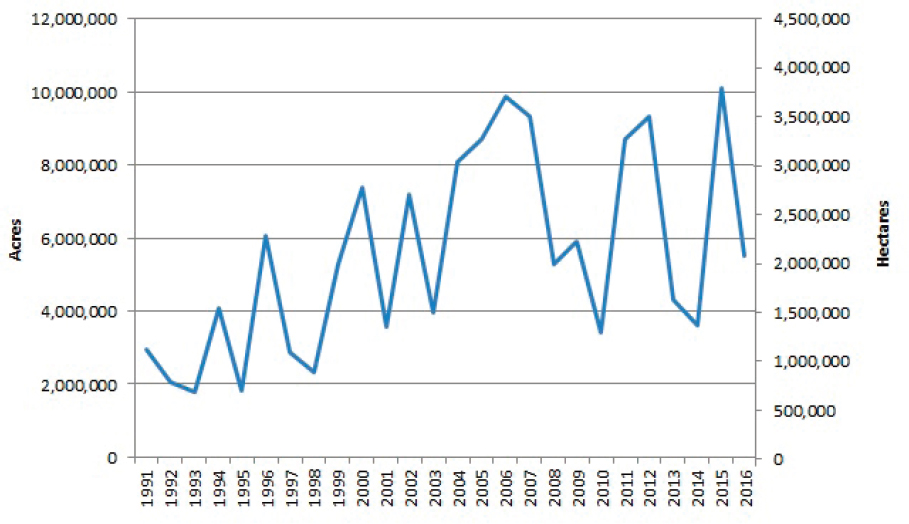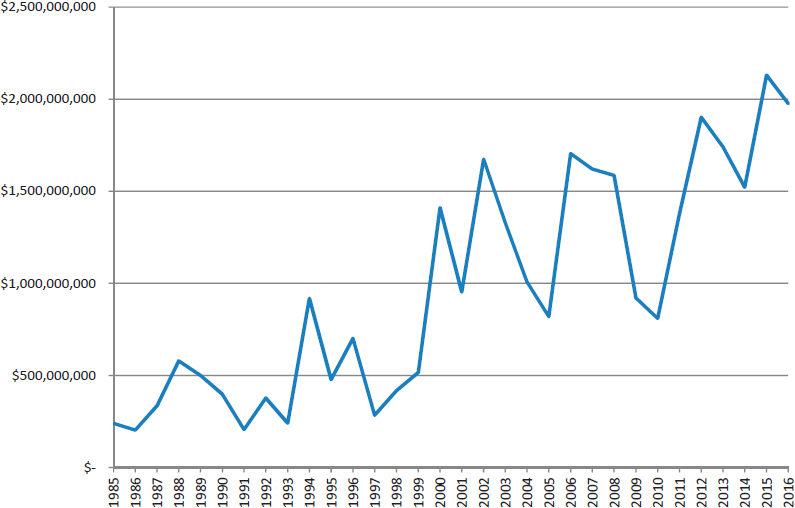1
Introduction
Although ecosystems, humans, and fire have coexisted for millennia, changes in geology, ecology, hydrology, and climate as well as sociocultural, regulatory, and economic factors have converged to make wildland fire management exceptionally challenging for U.S. federal, state, and local authorities. Increasingly dry conditions, stresses on native flora and fauna (including those imposed by invasive species), and landscapes that have been altered both by humans and previous wildland fires all shape the management options available today when it comes to wildland fire (Coughlan and Petty, 2012; Flannigan et al., 2013). Such changes can result in compounding ecological effects such as erosion and landslides, new river and stream patterns, and different composition and functioning of ecosystems (for example, Miller et al., 2013; Riley et al., 2013). Changes to human settlement patterns, particularly the trend to build and occupy permanent structures along the edge of wildland (that is, within the wildland–urban interface), similarly affect management options (Mercer and Zipperer, 2012). The confluence of factors also affects and often limits the approaches available for living with wildland fire.
Wildland fire includes both prescribed fire (fire that is deliberately ignited to meet specific objectives) and wildfire (unplanned fire in wildland). In 2014, over 4.7 million hectares (12 million acres) in the United States were treated with prescribed fire (Melvin, 2016). That same year, 1.5 million hectares (3.6 million acres) of wildland burned due to wildfire (NICC, 2014). In the following year, that area nearly tripled to 4.1 million hectares (10.1 million acres) (NICC, 2015). The amount of area burned by wildfire has been increasing steadily in the United States over the last 3 decades (Figure 1-1), as have the costs to federal agencies of suppressing wildfires (Figure 1-2). These rising suppression costs consume more of the agencies’ budgets and frequently cause funding for preemptive fire and forest management activities, such as prescribed burning and forest thinning, to be diverted to emergency firefighting efforts (WFLC, 2010).
However, suppression costs do not capture the full cost of fire. Even with the resources devoted to suppressing wildfire, destruction and damage occur, often with extremely tragic outcomes. For example, in the 2016 fire season the Great Smoky Mountains wildfires near

NOTE: Data include Alaska and Hawaii.
DATA SOURCES: NICC, 2000, 2001, 2002, 2003, 2004, 2005, 2006, 2007, 2008, 2009, 2010, 2011, 2012, 2013, 2014, 2015, 2016.

NOTE: Costs are not adjusted for inflation.
DATA SOURCE: Federal Firefighting Costs (Suppression Only), available at https://www.nifc.gov/fireInfo/fireInfo_documents/SuppCosts.pdf. Accessed June 18, 2017.
Gatlinburg, Tennessee, killed 14 people, injured 130, and forced 14,000 to evacuate the area. More than 1,600 structures were damaged or destroyed by this one fire complex (Gabbert, 2016). Costs related to rehabilitating a burned area (including short-term clean-up efforts and long-term environmental restoration), lost tax and business revenue and property value following a wildfire, health effects from smoke exposure, emergency evacuations, and loss of life can swamp the expense of fighting fires, sometimes reaching 30 times the amount spent on a fire’s suppression (WFLC, 2010).
The increasing proportion of federal, state, and local budgets directed to fire suppression reduces the capacity of those agencies responsible for managing wildlands to develop and implement long-term strategies that account for the full wildland fire cycle of mitigation, preparedness, response, and recovery. With extensive wildland–urban interfaces, the United States is particularly exposed to the financial risks of managing wildland fire relative to the rest of the world.
Although federal agencies—and their state and local counterparts—make significant efforts to coordinate their activities, leverage resources, and define future priorities through interagency mechanisms such as the Joint Fire Science Program, the National Cohesive Strategy for Wildland Fire Management, and the National Interagency Fire Center, these institutions nonetheless struggle to collectively address managing fires in wildland areas and to develop strategies for making landscapes resilient to wildland fire over the long term. There is general agreement that high quality wildland fire science is available but that translating this science into actionable policy initiatives is difficult.
Therefore, given the mounting, unsustainable costs and difficulty translating existing wildland fire science into policy, the National Academies of Sciences, Engineering, and Medicine organized a 1-day workshop to focus on how a century of wildland fire research can contribute to improving wildland fire management. The workshop was organized at the behest of the U.S. Forest Service.
OVERVIEW OF THE WORKSHOP
The workshop was organized and convened by a planning committee and held on March 27, 2017, at the National Academy of Sciences in Washington, DC (see agenda in Appendix A). The planning committee (see biographies in Appendix B) developed the agenda around a statement of task (Box 1-1) established by the National Academies and the U.S. Forest Service. Participants were drawn from the Forest Service, the U.S. Department of the Interior, other federal agencies, nongovernmental conservation organizations, universities, and emergency management organizations. More than 100 people attended the workshop, and an additional 200 participated remotely via webcast.
The workshop began with a welcome from Dr. Gregory Symmes, executive director of the National Academies’ Division on Earth and Life Studies, and presentations on the legacy of fire science research in the U.S. Forest Service. Keynote speakers and panelists then spoke about the following concepts:
- Learning from more than 100 years of fire science research
- Anticipating future fire regimes
- Understanding the current state of fire science research
- Understanding the complexities of living with wildland fire
Following presentations on the above concepts, some workshop participants broke into multidisciplinary working groups to explore pinpointing research priorities for different U.S.
regions, using technology in wildland fire management, integrating science into management actions, and engaging stakeholders.
ORGANIZATION OF THE PROCEEDINGS
This proceedings of a workshop summarizes presentations and discussions on ways in which science can help wildland fire planning and management be more strategic, reduce costs, and ultimately increase resilience to wildland fire, both on the land and in communities affected by fire. Its organization follows the structure of the workshop. Chapter 2 summarizes remarks given by representatives of the U.S. Forest Service. Chapter 3 captures the presentations of the workshop’s two keynote speakers, who focused on the United States’ past and future with fire, respectively. Chapters 4 and 5 review the current understandings of the state of the science relative to fire and the challenges to living with fire. Biographies for all the workshop speakers can be found in Appendix C. Chapter 6 summarizes the results of the afternoon’s discussions in the breakout sessions.
This proceedings of a workshop has been prepared by the rapporteur as a factual summary of what occurred at the workshop. The planning committee’s role was limited to planning and convening the workshop. The views contained in the proceedings are those of individual workshop participants and do not necessarily represent the views of all workshop participants, the planning committee, or the National Academies of Sciences, Engineering, and Medicine.




